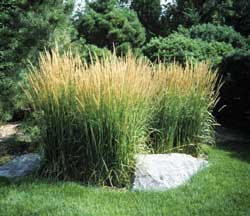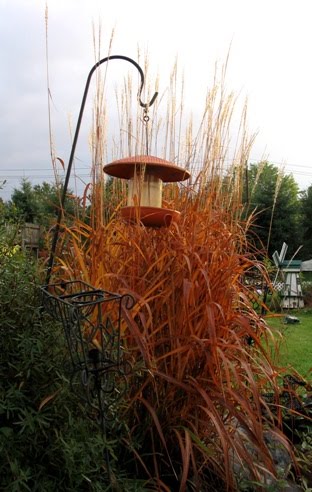Autumn has gone now but the splendid autumn grasses have motivated me to publish on them. These ornamental grasses are splendid in autumn but they can really transcend any season. Many of these grasses like Ravenna, Calamagrostis and tall Miscanthuses, can be left standing all winter. They perform elegantly in the garden for almost ten months of the year when they are cut back in very early spring to spur them intio another season's growth. Some of Carexes and other few retain their color for the whole year.

http://www.saversplanet.com/wallpapers/autumn-grass-wallpapers_10612_1600x1200.jpg
They are increasingly used in parks and public plantings, commercial landscaping of office buildings and even fast-food restaurants. They are quite easy to maintain, like they are cut back close to ground once a year and incidentally provide good attractive material for mulching. The best thing about these grasses is to observe them grow and change with the season. Additionally they grow very rapidly.
http://outdoorlifestyledesigns.com/ornamental_grasses.html
They are increasingly used in parks and public plantings, commercial landscaping of office buildings and even fast-food restaurants. They are quite easy to maintain, like they are cut back close to ground once a year and incidentally provide good attractive material for mulching. The best thing about these grasses is to observe them grow and change with the season. Additionally they grow very rapidly.
http://outdoorlifestyledesigns.com/ornamental_grasses.html
The elegant heights of these grasses make them conspicuous and well-suited for every type of garden. The appeal of these grasses lies mainly in their diversity.
Holcus mollis 'Variegatus', commonly known as variegated velvet grass for its green and white striped leaves with pinkish overtones and for its downy texture, grows no more than six inches high. It spreads a bit, but Festuca ovina 'Glauca' forms little domes or mounds, also low to the ground at about eight inches.
http://www.jacksonsnurseries.co.uk/images/plantpictures/large/grasses/HolcusAlbovariegata.JPG
http://www.sheffields.com/data/4877_GRAMINEAE_Festuca_ovina__var._glauca_.jpg
http://www.sheffields.com/data/3526_GRAMINEAE_Festuca_ovina__var._glauca_.jpg
Carex morrowii 'Variegata' forms not a mound but a mop.
http://www.plantes.ch/images/detailed/carex_morrowii_variegata.jpg
Grasses of intermediate size include Helictotrichon sempervirens, which makes spiky clumps about three feet high, with leaves arching gracefully at their tips.
http://www.bluestem.ca/images/helictotrichon-semp-04.jpg
There is also Pennisetum alopecuroides or fountain grass, which grows around 3.5 to 4 feet tall and produces an abundance of feathery, pink-toned flowers in late summer. Fountain grasses never overwhelm its neighbors in border. Growing them around yuccas for contrast make a nice combination.
http://www.ausgardener.com.au/product_images/x/pennisetum_fountain_grass__35678.jpg
http://www.ausgardener.com.au/product_images/x/pennisetum_fountain_grass__35678.jpg
Among the miscanthuses, Miscanthus sinensis 'Gracillimus' which grows between four and six feet tall and makes a fine upright accent in a border.
http://www.overdam.dk/mis-gracillimus.jpg
http://www.overdam.dk/mis-gracillimus.jpg
Calamagrostis acutiflora 'Stricta', with soft green leaves that weep slightly, forms a mound. In midsummer its narrow, erect, silvery pink flower spikes rise to five feet.
http://www.gapphotos.com/images/WebPreview/0046/0046061.jpg
http://www.gapphotos.com/images/WebPreview/0046/0046061.jpg
These grasses also vary widely in their color, both in a single species over the span of the year and from one species to the next.
The leaves of Miscanthus sinensis, a good shade of green in late spring and summer, gradually change to light tan as the autumn gets on, and its pink flower tassels go through several transformations, changing to pale, pale gold, then to straw, and finally to light beige.
http://www.bellevuebotanical.org/plantmonth/miscanthus_sinensis.jpg
http://www.bellevuebotanical.org/plantmonth/miscanthus_sinensis.jpg
Lyme grass (Elymus canadensis), a spreading and stoloniferous low plant that is tough enough to grow, is a pale gray-blue.
http://www.nicerweb.com/doc/class/pix/PRAIRIE/2005_07_27/Elymus_canadensis.jpg
http://www.nicerweb.com/doc/class/pix/PRAIRIE/2005_07_27/Elymus_canadensis.jpg
Some of the fescues and blue oat grasses (Helictotrichon semperviens) are still bluer.
http://www.gardenexpress.com.au/images/P/Blue_fescue_07-01.jpg
Pennisetum setaceum 'Burgundy Giant' has extremely handsome purple leaves. http://www.gardenexpress.com.au/images/P/Blue_fescue_07-01.jpg
http://www.itsaulplants.com/_ccLib/image/plants/DETA-61.jpg
Miscanthus sinensis 'Purpurascens' develops red tints in summer and by early October is almost scarlet.
http://www.bluestem.ca/images/miscanthus-purpurascens2.jpg
http://www.landscapedia.info/images/plant_images/Miscanthus_sinensis_purpurascens_silvergrassFlame_Grass_550_550.jpg
http://www.robsplants.com/images/portrait/MiscanthusPurpurascens041016.jpg
Panicum virgatum 'Rubrum', the red switch grass, shows reddish tones in the summer and turns crimson when night begin to cool down.
http://dovecreekgardens.com/images%2Fproducts%2F2008%2Fpanicum%20virgatum%20rotstrahlbusch.jpg
http://dovecreekgardens.com/images%2Fproducts%2F2008%2Fpanicum%20virgatum%20rotstrahlbusch.jpg
The champion of all the red grasses is Japanese blood grass (Imperata cylindrica 'Rubra'). Its leaves are dark burgundy for half their length at least from the time they first emerge in the spring. The color deepens in September and spreads to the entire length of the leaves. It is ensational when grown in combination with silver-stemmed Russian sage (Perovskia atriplicifolia) and blue oat grass.
http://www.spaldingbulb.co.uk/images/Catalog/normal/large/12889.jpg
http://ecx.images-amazon.com/images/I/51avwHylXiL._SL500_AA280_.jpg
Another Carex, Carex buchananii, is more of a novelty than a thing of beauty.
http://www.zahrada-zizka.cz/obr/Carex%20buchananii%202c000-301-03.JPG
Besides their subtle colors, ornamental grasses bring to the garden the important elements of movement and sound.




























http://hortist.blogspot.com/2010/01/glory-of-autumn-grasses.html?showComment=1262788227240#c8807824686666558700'> January 6, 2010 at 6:30 AM
Its really nice dear, keep it up!!!
http://hortist.blogspot.com/2010/01/glory-of-autumn-grasses.html?showComment=1262790699396#c2776398890410461231'> January 6, 2010 at 7:11 AM
Saif, these are EXCELLENT examples of ornamental grasses...a plant family many gardeners overlook. I have only a few variety since most are not hardy to zone 6 but I love them in pots for summer display.
Good to catch up with your posts...hope your father is doing well! Happy 2010!
Thanks for your visit, I truly appreciate it ;)
Lynn
http://hortist.blogspot.com/2010/01/glory-of-autumn-grasses.html?showComment=1262799417636#c8165356789009087659'> January 6, 2010 at 9:36 AM
unbelivable collection of oterwise neglected grass photos. Thanks for such a nice new year gift to our members of blog.
http://hortist.blogspot.com/2010/01/glory-of-autumn-grasses.html?showComment=1262884770571#c5157598933933656214'> January 7, 2010 at 9:19 AM
Greetings Saif from Scotland. I love the grasses in my garden but my favourites among them all are stipa and Calamagrostis. I would love to grow more but they are just not hardy enough or never produce the lovely seedheads in the Late Summer due to the short season.
http://hortist.blogspot.com/2010/01/glory-of-autumn-grasses.html?showComment=1262953744287#c4458850647750012233'> January 8, 2010 at 4:29 AM
Hi Saif, every single grass you show is a winner, and I agree that the blood grass is the champion, even if it is short in stature. The Carex group too, deserves your accolades. Well done! :-)
Frances
http://hortist.blogspot.com/2010/01/glory-of-autumn-grasses.html?showComment=1262955218050#c4465266499414009659'> January 8, 2010 at 4:53 AM
Thank you Frances :)
http://hortist.blogspot.com/2010/01/glory-of-autumn-grasses.html?showComment=1262971570598#c464033238685244942'> January 8, 2010 at 9:26 AM
Hello Hortist,
I just love ornamental grasses and I wish people would use more of them in the landscape. They are beautiful during the winter months when not much else is growing and they are low-maintenance. I love your pictures and like the burgundy colored grasses the best :-)
http://hortist.blogspot.com/2010/01/glory-of-autumn-grasses.html?showComment=1263007872308#c3573439871429028946'> January 8, 2010 at 7:31 PM
I love the use of ornamental grasses in the landscape - and in containers as well. I've recently added a lot and look forward to seeing them in their more mature state this summer!
http://hortist.blogspot.com/2010/01/glory-of-autumn-grasses.html?showComment=1263169389286#c2876306789518142251'> January 10, 2010 at 4:23 PM
What a nice collection of ornamental grass photos. It's fun to scroll through and get a quick snapshot of all the types of varieties...
http://hortist.blogspot.com/2010/01/glory-of-autumn-grasses.html?showComment=1263207788095#c1906980305000352167'> January 11, 2010 at 3:03 AM
@Nativeplants, thanks for visiting my blog and posting nice comments :)
http://hortist.blogspot.com/2010/01/glory-of-autumn-grasses.html?showComment=1264182123858#c682432394584775563'> January 22, 2010 at 9:42 AM
A stunning collection ...
Thank you for sharing, Saif :)
http://hortist.blogspot.com/2010/01/glory-of-autumn-grasses.html?showComment=1264753328447#c8603307933080848758'> January 29, 2010 at 12:22 AM
Grasses are beautiful when well kept, but if they are not attended - they really look wild and invasive.
In the tropical places where I live, all grasses are very much treated like a lawn material, nothing more than and inch long.
Above than that, its a considered a dangerous material as snakes loves to breed in these kind of places.
http://hortist.blogspot.com/2010/01/glory-of-autumn-grasses.html?showComment=1264764830024#c6729699231720514823'> January 29, 2010 at 3:33 AM
James, thanks for the nice as well as practically very important comments.
Yes true, the ornamental grasses need some maintenance to get them well attractive. But I think it's still a nice addition because they don't need too much care like other plants, and they make very nice contrast with other greenery in the lawns, parks, golf courses or in some other landscape ventures. Yeah this is true that there is a risk of snake breeding if they are used in large areas in a tropical regions with wild whereabouts.
Have a nice day :)